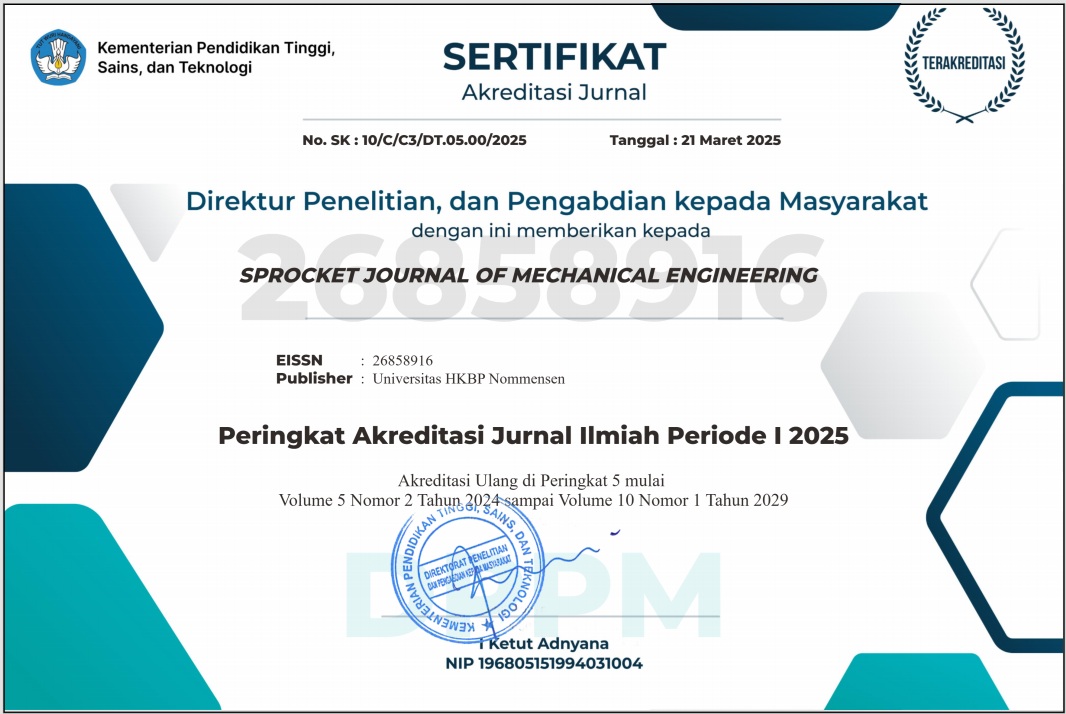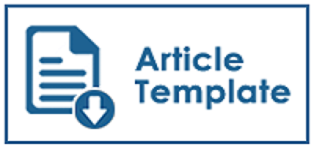Optimasi Parameter Proses 3D Printing Terhadap Kuat Tarik Material Filamen PLA + Menggunakan Metode Taguchi
Abstract
FDM (Fused Deposition Modeling) is one of the methods often usen by researchers in 3D printing technology which is used to print filaments products as a materials, due to the easy technique for 3D printing with relatively low production costs. One of the materials that can be processed in a 3D printing machine ia PLA+. Research in tensile testing has been done on PLA and ABS filaments. Meanwhile, tensile testing using PLA+ filaments is still rarely done. From these problems, research is needed to get the optimal process parameters on the 3D printing machine to get the highest tensile strenght value using PLA+ filaments. This research uses the taguchi method, carried out on a PRUSA area model FDM 3D Printing machine with dimensions of 300mm x 300mm x 350mm using a nozzle size of 0.4mm. The material used is PLA + Esun filament with a diameter of 1.75 mm with a variety of printing speed parameters (30 mm/s, 35 mm/s, 40 mm/s, 45 mm/s, 50 mm/s), nozzle temperature (1950C, 2000C, 2050C, 2100C, 2150C), layer thickness (0.10mm, 0.15mm, 0.20mm, 0.25mm, 0.30mm), cooling speed (20%, 40%, 60%, 80%, 100%), orientation (00, 300, 450, 600,900) which will be determined in ideamaker 3.6.1 to produce 75 printed samples. This research aims to determine the optimal tensile strength value. From the research results there is an optimal tensile strength value, namely in experiment 10 with the parameter values of printing speed (35 mm/s), Nozzle Tenperature (2150C), Layer Thickness (0.10mm), Cooling speed (20%), and Orientation (450). with a tensile strength value of 48.1 MPa from 3 replications.
References
[2]. Suzen, Z. S., Hasdiansah, & Yulianto. (2020). Pengaruh Tipe Infil Dan Temperature Nozzle Terhadap Kekuatan Tarik Produk 3D Printing Filamen Pla + Esun. Manutech, 1-8.
[3]. Kholil, A., Aufi, F., & Syaefudin, E. A. (2020). Pengaruh layer thickness dan orientasi 3D Printing terhadap uji tarik material ABS. NCIET, 1-8.
[4]. Andriyansyah, D., Herianto, & Purfaji. (2018). Optimasi Parameter Proses 3D Printing Terhadap Kuat Tarik Filamen Polylactic Acid Menggunakan Metode Taguchi. Departemen Teknik Mesin dan Industri Fakultas Teknik Universitas Gadjah Mada Yogyakarta Jl. Grafika No. 2 Yogyakarta 55281 Indonesia , 8.
[5]. Sutanto. Lubis, D. (2016). Pengaruh Posisi Orientasi Objek Pada Proses Rapid Prototyping 3D Printing Terhadap Kekuatan Tarik Materal Polymer. SINERGI Vol.20, No.3, Oktober 2016: 229-238, 1-10.
[6]. Soejanto, I. (2009). Desain Eksperimen dengan Metode Taguchi. Yogjakarta; Graha Ilmu.

This work is licensed under a Creative Commons Attribution 4.0 International License.
Penulis yang menerbitkan dengan SPROCKET JOURNAL OF MECHANICAL ENGINEERING menyetujui ketentuan berikut :
- Penulis memegang hak cipta dan memberikan jurnal hak penerbitan pertama dengan karya yang dilisensikan secara bersamaan di bawah Lisensi Internasional Creative Commons Atribusi 4.0 . yang memungkinkan orang lain untuk berbagi karya tersebut dengan pengakuan atas kepengarangan karya dan penerbitan awal dalam jurnal ini.
- Penulis dapat membuat pengaturan kontraktual tambahan yang terpisah untuk distribusi non-eksklusif atas versi jurnal yang diterbitkan dari suatu karya (misalnya, mempostingnya ke repositori institusional atau menerbitkannya dalam sebuah buku), dengan pengakuan atas penerbitan awalnya di jurnal ini.
- Penulis diizinkan dan didorong untuk mengunggah karya mereka secara daring (misalnya, di repositori institusi atau di situs web mereka) sebelum dan selama proses penyerahan, karena hal ini dapat mengarah pada pertukaran yang produktif, serta kutipan yang lebih awal dan lebih banyak dari karya yang diterbitkan (Lihat Pengaruh Akses Terbuka ).






.png)
.png)

